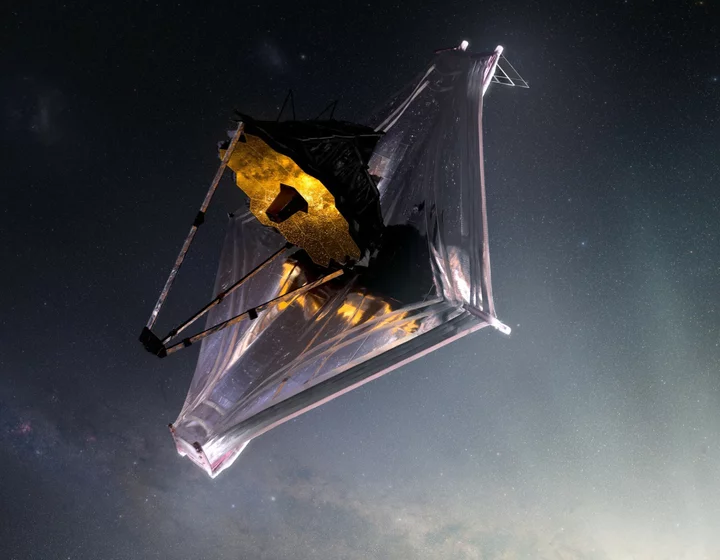The James Webb Space Telescope lets astronomers see a tremendous number of deep space galaxies — and they're finding some peculiar things.
Of note, scientists recently pointed the Webb telescope — the most powerful observatory in space — at a whopping 100,000 relatively young galaxies, and observed some unique cosmic phenomena in a galaxy dubbed CEERS 1019. It's extremely young, for a cosmic object, existing just some 570 million years after the big bang created the universe. And it holds the most distant supermassive black hole ever found.
Although this black hole (an object with a gravitational pull so strong not even light can escape) is billions of light-years away, the Webb telescope's ability to capture extremely faint energy allows researchers to observe what's happening in CEERS 1019.
"Looking at this distant object with this telescope is a lot like looking at data from black holes that exist in galaxies near our own," Rebecca Larson, an astronomer at the University of Texas at Austin who led the discovery, said in a statement.
SEE ALSO: Spectacular Webb telescope image reveals things scientists can't explainCEERS 1019 and its black hole are unique for a number of reasons:
- It might not be just one galaxy: Most galaxies appear as a singular disk. Not CEERS 1019. As the image below shows, it's made up of three bright clumps. "We’re not used to seeing so much structure in images at these distances,” said Jeyhan Kartaltepe, an astrophysicist at the Rochester Institute of Technology in New York, who worked on the research. The structures might be galaxies merging together, and stoking the creation of stars. “A galaxy merger could be partly responsible for fueling the activity in this galaxy’s black hole, and that could also lead to increased star formation," Kartaltepe added.
- Unusual black hole: "CEERS 1019 is not only notable for how long ago it existed, but also how relatively little its black hole weighs," NASA explains. It weighs 9 million times more than the sun, which is a lot, but not compared to the giants often found at the center of galaxies in the young universe, which are 1 billion times (or more!) heavier. What's more, astronomers don't yet know how such a powerful object exists at all. It appeared so early in the universe, when the first galaxies were forming. With the help of the Webb telescope, researchers hope to grasp how such a big galaxy, and other massive objects, came to be.
- Ravenous eater: What is clear, however, is the black hole found in CEERS 1019 is extremely active. "Though small, CEERS 1019 is ravenous, consuming gas, dust, and stars at the highest theoretically possible rate for its size," the Space Telescope Science Institute, which operates the observatory's science mission, explains. "Webb’s spectrum reflects it is fully focused on eating its 'meal.'" (By peering at distant light, Webb's specialized instruments can view the chemical makeup of objects billions of light-years away. In other words, we don't have a picture of this black hole, but we know how black holes behave, and can determine what's transpiring at such great distances by observing the activity of atoms or molecules in the deep cosmos.)
A graph showing how the James Webb Space Telescope observed gas behavior in the galaxy CEERS 1019, which illustrates the behavior of an exceptionally busy black hole. Credit: NASA / ESA / CSA / Leah Hustak (STScI)These findings will be published in the peer-reviewed science journal The Astrophysical Journal Letters. And expect more discoveries from this expansive survey of 100,000 galaxies.
"CEERS 1019 may only hold this record for a few weeks – claims about other, more distant black holes identified by Webb are currently being carefully reviewed by the astronomical community," NASA said.
The Webb telescope's powerful abilities
The Webb telescope — a scientific collaboration between NASA, the ESA, and the Canadian Space Agency — is designed to peer into the deepest cosmos and reveal unprecedented insights about the early universe. But it's also peering at intriguing planets in our galaxy, and even the planets in our solar system.
Want more science and tech news delivered straight to your inbox? Sign up for Mashable's Light Speed newsletter today.
Here's how Webb is achieving unparalleled feats, and likely will for decades:
Giant mirror: Webb's mirror, which captures light, is over 21 feet across. That's over two and a half times larger than the Hubble Space Telescope's mirror. Capturing more light allows Webb to see more distant, ancient objects. As described above, the telescope is peering at stars and galaxies that formed over 13 billion years ago, just a few hundred million years after the Big Bang.
"We're going to see the very first stars and galaxies that ever formed," Jean Creighton, an astronomer and the director of the Manfred Olson Planetarium at the University of Wisconsin–Milwaukee, told Mashable in 2021.
Infrared view: Unlike Hubble, which largely views light that's visible to us, Webb is primarily an infrared telescope, meaning it views light in the infrared spectrum. This allows us to see far more of the universe. Infrared has longer wavelengths than visible light, so the light waves more efficiently slip through cosmic clouds; the light doesn't as often collide with and get scattered by these densely packed particles. Ultimately, Webb's infrared eyesight can penetrate places Hubble can't.
"It lifts the veil," said Creighton.
Peering into distant exoplanets: The Webb telescope carries specialized equipment called spectrometers that will revolutionize our understanding of these far-off worlds. The instruments can decipher what molecules (such as water, carbon dioxide, and methane) exist in the atmospheres of distant exoplanets — be it gas giants or smaller rocky worlds. Webb will look at exoplanets in the Milky Way galaxy. Who knows what we'll find?
"We might learn things we never thought about," Mercedes López-Morales, an exoplanet researcher and astrophysicist at the Center for Astrophysics-Harvard & Smithsonian, told Mashable in 2021.
Already, astronomers have successfully found intriguing chemical reactions on a planet 700 light-years away, and the observatory has started looking at one of the most anticipated places in the cosmos: the rocky, Earth-sized planets of the TRAPPIST solar system.









